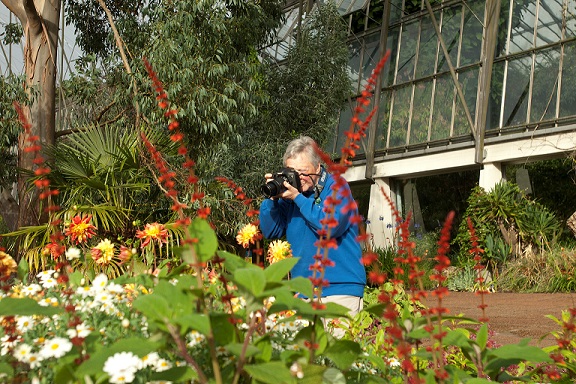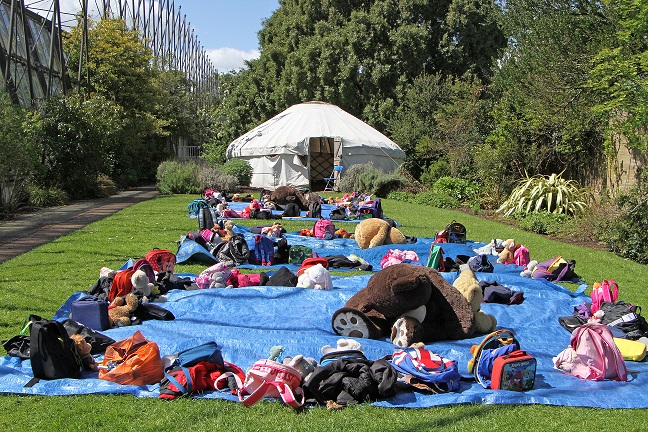A series of posts from our volunteers …
Brenda White – A Photography Volunteer

Long ago, when the world was simple, and taking photos involved no more effort than taking the film out of the camera, taking it down to the local chemist and, two days later, walking back to the chemist to get the fat packet of colour prints. . . I went on a weekend course at RBGE on photographing plants and flowers. It was wonderful… the bliss of two whole days out in a huge garden, taking photographs, nothing else to think about! And I learned such a lot, too, from the then RBGE Photographer Debbie White. When some of the class reassembled a week later to compare results, I stayed on and chatted to Debbie about the possibility of being a photography volunteer. I was accepted!
At first, I just went out and about in the Garden taking photos of flowers and trees. That was the day of slides, and you took five shots of everything – one at the exposure that the camera told you, two half stops below and two half stops above. It was called bracketing. You got through the rolls of film very quickly!
Then I was pulled into a small team under the aegis of the Education Department to compile posters for schools showing the evolution of plants. There were two photography volunteers on the team and we were to get good images of required subjects. One that I particularly remember was going out to Dobbies’ Butterfly House to get images of butterflies; that was my first experience of my lens getting misted up in a hot climate. By the time it had unmisted, the butterflies had all gone back to sleep!
Eventually, things became more organised, and I settled into a pattern of work. One element of this was to work in the Studio scanning the contents of the slide archive into the digitised database and assigning keywords to the images. There was a large four-drawer filing cabinet full of slides and unmounted transparencies in folders going back about 20/30 years. I started on the drawer for the Edinburgh Garden; then I did Benmore, Logan and finally Dawyck. It was a slow process. The Nikon slide scanner took 6.5 minutes to scan five slides at a time; the Hasselblad scanner for the transparencies took about 1.5 minutes for each item. Including keywording, I might get through about 20-30 items in a good morning. As each Garden’s collection has about 1,500 items, it all took a long time. Well over 10 years! Then I retired from scanning.
My other regular work over these years has been to take photos of the classes and courses run by the Education Department for primary and secondary schools, for students, and for adults. The photos are used principally in the brochures and web sites that publicise the teaching programmes.
Photographing school classes is very different from taking composed shots of plants! The youngest children do things like Teddy Bears’ Picnic, where they search for Edward Bear throughout the Garden, and learn how living things develop.

Older primary children have programmes such as Rainforest Adventure and The Life of Plants, which are more serious in content. Secondary schools have programmes in ecology and biodiversity, which feed into the national curriculum. All of these are photographed on the move, sometimes fairly rapid move, so it is very much a matter of “pot-shotting” and hoping that the resultant 2-300 pics will yield 30-40 good images! Thank goodness for digital!!!
Photographing the adult education classes, on the other hand, is a fairly static business, where everyone is sitting at a desk or standing around a lab table, so it’s possible to focus better and get a range of shots from groups to close-ups of hand with brush. There is time and space to concentrate on the subject, to get the exposure right, even to work out some depth of field. Sophisticated stuff!
From time to time I have been asked to take photos for a specific event or publication or web site: for example, I spent a happy summer week at Logan taking photos for its publicity brochure; I spent another summer working on images for the Certificate in Practical Horticulture for use on its website.
In January of 2020, I received a gold certificate for 15 years’ of volunteer work. It has been a happy time. Being a photography volunteer with RBGE makes for a full life, with much variety, much satisfaction, and many friends. The sense of being part of a team, with both staff and other volunteers, is rewarding; contacts with tutors and students on the adult courses has also been fun.
Although at the time of writing this, we are in the throes of Covid-19, I hope that in the fullness of time we can all look forward to many more happy years in our Garden.
